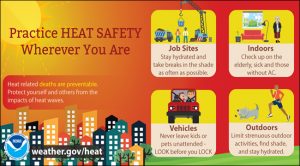Don’t become a statistic — follow these tips to beat the heat
July 11, 2018Though this summer hasn’t been as consistently hot as others (yet), we’ve already had our fair share of blistering temps and heat warnings. As we head into the middle of July, you can be sure more heat waves are likely.
Every year, there are grim news stories about children or pets who’ve been locked in cars, and each heat wave is accompanied by reports of widespread cases of dehydration and heat stroke.
Don’t let yourself or someone else become a statistic. There are a few things you can do to avoid becoming a statistic.
Preventing a tragedy is a no-brainer: Never, ever leave a child, disabled person or pet locked in a car — no matter what time of year it is. According to the National Weather Service, the first heat-related toddler death in 2018 occurred in February. Cars turn into ovens when sitting in the sun, even with the windows open. Even on a day when it’s just 70 degrees outside, a car interior can reach 113 degrees in just a half-hour.
The easiest way to prevent dehydration is a no-brainer, too: drink plenty of water.
As the John Hopkins Health Library points out, dehydration can happen when “an individual is overexposed to the sun and not drinking enough water. This is caused when the body loses water content and essential body salts, such as sodium and potassium.” The problem can be compounded if you’re ill, or taking certain types of medicine such as diuretics.
Proper hydration helps keep the body in balance, especially when it’s hot. As an article on National Geographic’s website explains, when we become dehydrated, “blood flow to the skin decreases, along with the ability to sweat. Body heat builds up.”
When the body reaches a temperature of 104 degrees, we’re in the danger zone. The article explains that a temperature of 105 degrees is the definition of heat stroke; and “a temperature of 107 degrees could result in irreversible organ damage or even death.”
There are plenty of so-called sports drinks on the market that claim to replenish much-needed substances like electrolytes and sodium. While these are fine once in a while, medical experts say the best way to meet your hydration needs is to drink plain old water.
A WebMD article breaks down the importance of H20 and proper hydration:
Water makes up about 83% of blood, 73% of muscles, 25% of body fat, and 22% of bones.
Water keeps every part of your body working properly. It helps your body flush wastes and stay at the right temperature.
Cold water hydrates, cools, and refreshes you like nothing else.
The next time a heat wave hits, take these pointers from the National Weather Service to stay safe, and watch out for symptoms of heat-related illnesses:
Safety Tips for Adults
- Slow down. Reduce, eliminate or reschedule strenuous activities until the coolest time of the day. Children, seniors and anyone with health problems should stay in the coolest available place, not necessarily indoors.
- Dress for summer. Wear lightweight, light-colored clothing to reflect heat and sunlight.
- Put less fuel on your inner fires. Foods, like meat and other proteins that increase metabolic heat production also increase water loss.
- Drink plenty of water, non-alcoholic and decaffeinated fluids. Your body needs water to keep cool. Drink plenty of fluids even if you don’t feel thirsty. Persons who have epilepsy or heart, kidney or liver disease, are on fluid restrictive diets or have a problem with fluid retention should consult a physician before increasing their consumption of fluids. Do not drink alcoholic beverages and limit caffeinated beverages.
- During excessive heat periods, spend more time in air-conditioned places. Air conditioning in homes and other buildings markedly reduces danger from the heat. If you cannot afford an air conditioner, go to a library, store or other location with air conditioning for part of the day.
- Don’t get too much sun. Sunburn reduces your body’s ability to dissipate heat.
Heat-Related Illness Symptoms and First Aid
HEAT CRAMPS
- Symptoms:
- Painful muscle cramps and spasms usually in legs and abdomen
- Heavy sweating
- First Aid:
- Apply firm pressure on cramping muscles or gentle massage to relieve spasm.
- Give sips of water, if nausea occurs, discontinue water
HEAT EXHAUSTION
- Symptoms:
- Heavy sweating
- Weakness
- Cool, pale, clammy skin
- Weak pulse
- Possible muscle cramps
- Dizziness
- Nausea and vomiting
- Fainting
- Normal temperature possible
- First Aid:
- Move person to a cooler environment
- Remove or loosen clothing
- Apply cool, wet cloths
- Fan or move victim to air-conditioned room
- Offer sips of water. If nausea occurs, discontinue water. If vomiting continues, seek immediate medical attention.
HEAT STROKE (or sunstroke)
- Symptoms:
- Altered mental state
- Possible throbbing headache, confusion, nausea, dizziness, shallow breathing
- High body temperature (106°F or higher)
- Skin may be hot and dry, or patient may be sweating
- Rapid pulse
- Possible unconsciousness
- First Aid:
- Heat stroke is a severe medical emergency. Summon emergency medical assistance or get the victim to a hospital immediately. Delay can be fatal.
- Move the victim to a cooler, preferably air-conditioned, environment
- Reduce body temperature with a water mister and fan or sponging
- Use fan if heat index temperatures are below the high 90s
- Use extreme caution
- If temperature rises again, repeat process
- Do NOT give fluids